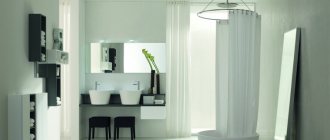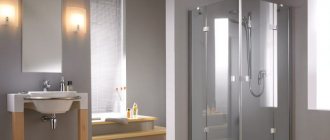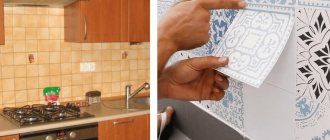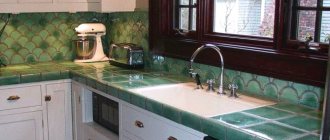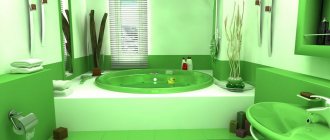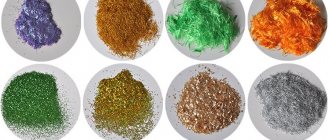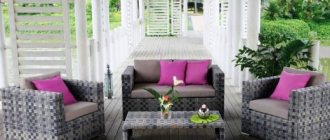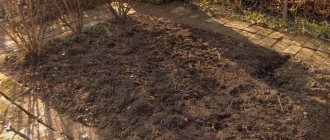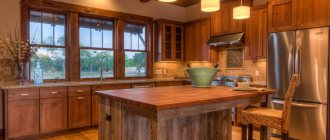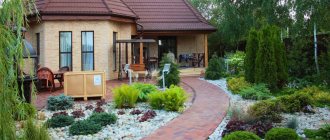Articles
12.05.2017 2581
When planning a unique bathroom design, it is important to consider every detail. Beautiful cladding, laying mosaics on the floor in a shower stall will be a beautiful and practical solution. Such an original design move will be a useful addition to any cabin configuration, and the possibility of laying a mosaic floor with your own hands makes it possible to significantly save the family budget.
Electric floor features and installation
Electric heated floors in the bathroom are a relatively modern type of heating. Unlike a water floor, an electric floor is much easier to install and operate. Its advantages include:
- Easy installation. Installing a heated floor in a bathroom is much simpler than a water floor. Preparatory work is minimal.
- Uniform heating. Due to the use of cable, the entire floor surface will have the same temperature.
- There is no need to obtain permits. Installation of an electric floor is not considered remodeling.
- Price. The purchase of components and building materials will be much cheaper compared to water floors.
Despite the impressive list of advantages, the electric floor also has its disadvantages:
- Communal payments. Powered by a common network, such a floor consumes a lot of energy.
- The need to conduct a separate branch of the electricity supply. This type of flooring requires a certain voltage in the network.
- Restrictions on furniture placement. If you plan to place a cabinet in the bathroom, you should take into account that it will be subjected to intense exposure to fairly high temperatures.
In addition, many people have concerns about whether it is safe to install electric heated floors in the bathroom. Yes, it is absolutely safe, since the electrical cable is hidden under a layer of screed and will have neither direct contact with water nor with humans.
Installation of a heated floor in a bathroom begins with a separate power supply line. It is to this that an electrical cable and thermostat will later be connected, with which it will be possible to accurately regulate the temperature. Heat-insulating material is laid on the surface, thereby avoiding heat loss and directing it in the right direction.
After this, the cable itself is attached using a special mounting grid. In this case, the bend angle does not affect the efficiency of the system. The final stage consists of pouring the screed and laying the floor covering.
What other materials are required for laying mosaics?
Tile adhesive for mosaic flooring
In order for mosaic tiles to adhere securely to the floor surface and last as long as possible, you must choose the right adhesive for laying them. When choosing it, the material used to make the cladding and the microclimate of the room in which it will be used are taken into account.
Today on the construction market you can find three types of adhesive compositions for installing ceramic and stone tiles, made on different bases - these are cement, reactive (epoxy) and dispersion. To indicate the characteristics of the adhesive, in accordance with European standards EN 12004, classification numbers and letters are used, which are affixed by the manufacturer on the packaging of the compositions. The first letter indicates the binder material, the number indicates the main class of the glue, and the letters indicate the additives used in its composition.
An example of marking on a tile adhesive package.
| Glue type | Type of composition |
| C | Cement glue |
| R | Reactive adhesive - consists of several components |
| D | Dispersion adhesive - water-based polymer (ready for use) |
| Classification | Features of the composition |
| Main class 1 | Base |
| Main class 2 | Reinforced, for difficult bases |
| F | Quick setting composition. |
| T | Thixotropic - resistant to vertical sliding. |
| E | Composition with an increased pot life of the exposed layer. |
| S1 | Elastic composition. |
| S2 | Composition with increased elasticity. |
As can be seen from the table, the markings of adhesive compositions having classes “1” and “2” may additionally contain the letter designations “ E ”, “ T ” and “ F ”, for example, C2F , C1F , C2TE , C1TE , etc. .
Prices for mosaic tiles
mosaic tiles
If the glue marking contains the letter “ F ”, this indicates that the applied composition will quickly set and dry. You can walk on tiles fixed with such a solution within 3-5 hours, which is very important when repairs need to be made as quickly as possible. The adhesive is suitable for laying tiles made from natural stone, which are planned to be laid in a room with high humidity.
Glue marked with the letter “ T ” is intended primarily for cladding vertical and ceiling surfaces of a room.
The “ E ” marking means that the prepared composition will be suitable for gluing cladding even 30 minutes after applying it to the base. Such mixtures are especially convenient for inexperienced craftsmen, since it becomes possible to carefully adjust the tiles laid on the surface.
Adhesives “ S1 ” and “ S2 ” are defined as plastic, that is, retaining a fairly high degree of elasticity after drying, withstanding heavy loads and even deformation of the base. These compounds are used in cases where the elasticity of class “2” compounds is not enough, for example, when lining the surfaces of swimming pools, bathrooms and showers.
Cement based adhesive
Cement-based adhesive goes on sale in the form of dry construction mixtures, packaged in multi-layer paper bags with a net weight of 25÷30 kg. This type of glue can include various additives - there are universal, strong, lightweight and specialized mixtures.
The standard packaging for cement-based adhesives is paper bags of 25 or 30 kilograms.
Cement-based adhesive is suitable for laying ceramic and stone tiles laid in rooms with a humid microclimate. Many compositions allow for cladding, including in unheated rooms and outdoors.
Reactive (epoxy) glue
Reactive adhesives do not require water to prepare for use. Their strength gain occurs due to chemical reactions of the compounds included in their composition. Thus, most often these are two-component compositions, mixed immediately before installation. There are certain one-component brands in which hardening is caused by contact of the adhesive mass with air and water vapor.
Reactive adhesives can be divided into three subtypes:
- Composition containing mineral filler.
- Adhesive with thin filler.
- Flowable composition without filler.
It is hardly wise to use expensive two-component adhesive for laying mosaic tiles on a completely flat floor unless absolutely necessary.
Reactive adhesives are well suited for laying tiles on non-standard surfaces, for example, a sloping floor in a shower stall or its enclosure. The compositions are also suitable for tiling wooden or metal surfaces. The compositions have a fairly high cost, so if you are covering a smooth, high-quality floor surface, then there doesn’t seem to be much point in spending money on them.
Dispersion glue
This type of tile adhesive is not suitable for laying cladding on a concrete base. But if you plan to fix the material on plasterboard surfaces, then you won’t find it better.
Bucket of dispersive acrylic tile adhesive, ready to use.
The composition has the qualities of deep penetration into the base material and demonstrates excellent adhesive abilities with a surface properly prepared for finishing.
These dispersion adhesive mixtures are sold in ready-made plastic buckets, which greatly simplifies and speeds up the work. This type of glue contains acrylic resins and astringent components, which are easily diluted with ordinary water.
How to choose adhesive for mosaic tiles?
When choosing an adhesive for tiling a bathroom floor with mosaic tiles, you must consider the following factors:
- Material for making tiles.
- Base material - screed, wood, metal, etc.
- Moisture resistance of the composition.
- Abrasion resistance.
- Elasticity.
- Heat resistance if heated floors are planned.
As a rule, bathroom floors are made of concrete screed, leveled with a self-leveling compound. Taking this and all the above factors into account, we can come to the following:
- For installation of ceramic tiles, moisture-resistant cement and reactive adhesives can be used.
- If glass mosaic tiles are used for cladding, then one of the reactive two-component epoxy-based adhesives is best suited for fixing them.
- For laying tiles made of stone, both cement and epoxy adhesive are used. If the facing material is laid only on a flat surface, then a moisture-resistant cement-based adhesive will be what is needed. When finishing curved surfaces, it is recommended to use a reactive composition.
Prices for tile adhesive
tile adhesive
Grout for mosaic tiles
Another necessary material that must be selected correctly is grout for joints (or, otherwise, fugue). The quality of the grout determines the tightness of the tile cladding, which, in turn, directly affects the durability of the finish, especially in conditions of high humidity or direct contact with water.
The fugue can be made on a cement or epoxy base. Brief characteristics of these materials will help you decide on the choice of a more suitable mixture:
The most popular and affordable are cement-based grouts.
- Cement grouts are the most popular, as they are easy to work with not only for professional tilers, but also for beginners. This material is made from special cement, fine sand and auxiliary components that provide the necessary performance qualities - these are water repellents, plasticizers and stabilizers. Each manufacturer includes different additives in the material, so accurate information about them can only be found by examining the packaging.
Dry cement grouts can be mixed with either water or a latex composition, which will significantly improve the hydrophobic properties of the material. Seams sealed with cement fugue have a porous, rough surface that easily absorbs dirt and dust. To ensure that the seams are protected from dirt and moisture, it is recommended that they be additionally treated with water-repellent polymer varnish. This layer will help maintain the tightness of the masonry and the seams in their original form for as long as possible.
Cement grouts are for the most part suitable for both regular and mosaic facing tiles made from different materials.
- Epoxy two-component grout has the highest qualities of moisture resistance and strength. In addition, over time, this material does not lose its original performance characteristics and does not change its original appearance.
Epoxy grout is expensive, but it has no equal in terms of reliability.
It is quite possible to add decorative additives to the epoxy fugue, which make the frozen seams more aesthetically pleasing - these can be glitter of various colors or mother-of-pearl.
The seams of the mosaic masonry are filled with epoxy grout with glitter sparkling in the light.
After hardening, the grout acquires high strength and resistance to mechanical damage. The seams are perfectly smooth, which prevents dirt from lingering on their surface, therefore, unlike cement joints, they do not require additional protection.
Prices for grout for tiles
tile grout
The use of epoxy grout requires good skill from the master.
However, one should take into account the difficulty of working with epoxy grouts; the mixture turns out to be quite thick and in order to completely fill the seams with it, some effort has to be made. In addition, after combining the two components, the pot life of the solution is only 25-30 minutes - then its irreversible polymerization begins, which will significantly reduce the quality of sealing of the cladding. Therefore, epoxy fugue must be mixed in small portions and processed quickly.
Despite such shortcomings, the costs and efforts are worth it, since the mosaic coating sealed with this material can be called eternal.
In addition to the indicated characteristics of the materials, it makes sense to take into account other factors that experienced tilers recommend paying attention to:
If the thickness of the joints is at least 3 mm, then the grout must have a fine sand filling.
- If the seams between the tiles are planned to be 3 or more millimeters, then it is advisable that the grout should include fine sand, as it will prevent the formation of cracks when the grout hardens.
- For floor mosaic coverings, you should not choose a white fugue, as it will quickly take on an unpresentable appearance, changing its shade to dirty gray. If dark tiles are chosen for cladding, then the grout should be one or two shades darker. In the same case, when you plan to lay light-colored tiles, grout of the same color or a tone lighter than it is suitable, but still not white.
You can tint the grout yourself, but stores also offer a fairly wide range of compounds that already have a certain color.
- On sale you can find grout made from white or gray cement. To get a certain shade of fugue, it is better to choose the first option of the mixture, and when making the solution, add the desired color to it. Gray grout is suitable if the seams between the tiles must remain dark.
If you are not sure that you will be able to independently create the desired grout color based on white by adding color, then it is best to purchase a fugue with a shade already given initially that is most suitable for the finish being created.
Heated floor in the shower room
In the room where the shower is located, it is convenient to use both a cable tie and heating mats. The latter are easier to install, since they do not need to be filled with screed, and the cable itself is already attached to the mesh, which just needs to be glued to the floor. Please note that heating mats are used only for additional heating and are not used for main heating.
The system power is also 150-180 W/sq.m. The cable quality requirements are the same as in the case of a shower: double insulation and protection from moisture. The system does not fit under a shower stall with a tray, as well as under a washing machine, bathtub and other heavy stationary objects.
For installation in a shower room, you can use all brands of Energy heated floors, including Energy Mat heating mats and
Due to the rather cramped bathrooms provided by Soviet-era developers, many apartment owners in multi-story buildings are replacing bathtubs with showers. There is more space in the bathroom, and an elegant shower cabin fits into modern interiors much better than an old bathtub.
When planning to install this type of equipment, you will certainly encounter problems with its installation. Therefore, many home craftsmen are interested in installing a floor in the shower, because installing such a system with your own hands means saving a significant amount of money on the services of specialists. Below we will talk about how to arrange a shower on the floor.
Gutter installation
In the answer to the question “how to make a shower tray with your own hands,” the installation of a drain (or drain) occupies a special place. It will be extremely difficult to correct problems once the pallet and cladding are completed, so it is very important to ensure high quality.
Installation of a ladder in a screed
To do this, you must use the following rules and recommendations:
- The connection between the drainage point and the sewer system is made with a slope of about 3°. This ensures optimal flow rate and prevents blockages and stagnation of water in the shower pan.
- The joints of all elements must be sealed.
- For installation, it is recommended to choose plastic pipes and fittings of the highest quality. They can serve for a very long time because they are not subject to corrosion and destruction from other types of external influences.
- The drain ladder must be firmly fixed. The foundation is poured only after making sure that the structure will not move either at the time of pouring or during the process of strengthening the mortar.
Shower drain installation diagram
Read about how to choose and install a siphon for a sink with overflow in another article.
Recently, a hygienic shower in the toilet has become increasingly popular. Find out more about this on our website.
And there is information about the types of water meters at this address https://okanalizacii.ru/santeh_vodoprov/schetchiki/kak-vybrat-schyotchiki-vody.html
Preparing the base for laying tile material
Before laying the tiles, it is necessary to level the floor surface and make a slope towards the drain. To ensure the required slope when pouring a concrete screed, guide rails are used.
Preparation of the base is an important stage of cladding. You cannot skimp on materials - the base must be strong. It is necessary to waterproof the floor and slope to the drain.
Stages of work:
One of the options for preparing the floor for laying tiles
- the slope towards the drain hole is made at the rate of 1 cm of height difference per 1 meter of laying area;
- the drain hole must be made when constructing the foundation;
- to prevent air from the sewer from entering the steam room, water seals are installed in the sewer pipe;
- the concrete base is poured with a cement-sand screed, and the wood requires more complex preparation;
- when preparing a wooden base, you need to make sure the strength of the floorboards and replace them if necessary;
- there should be a gap of 1 cm along the perimeter between the boards and the walls. If there is no gap, the movement of the boards during temperature changes will destroy the cladding;
- All existing holes must be filled with putty and the wood treated with heated drying oil. This will be the first layer of waterproofing;
- the second layer is made using roofing felt;
- a reinforcing mesh is laid on top of the roofing felt and the screed is poured;
- When laying floor tiles on a mortar, the slope can be created during the tiling process.
How to make a shower tray from mosaic?
When installing a shower tray, you can always show your individuality and creativity, although the entire process involves the work of replacing plumbing, waterproofing and laying tiles. Shower trays are made independently in conditions of a limited budget, when purchasing a shower box or bathtub is difficult.
The shower tray is made of cement, brick, glue, waterproofing and grout.
The plumbing market is represented by a large number of pallets, which can be metal, cast iron or acrylic. Brick, concrete or tiles are sometimes used to create pallets. The shape of the pallet can be completely different. An important step is the preparation of a high-quality, even base for the pallet.
What is a ladder
A drain or shower drain is one of the elements of plumbing fixtures designed to organize a shower stall without any tray and perform several additional functions:
- draining water into the sewerage system;
- filtration of drainage water from various objects, as well as debris;
- preventing unpleasant odors from the sewerage system from entering the bathroom and living quarters;
- ensuring the possibility of cleaning the sewer drain.
The design of the shower drain consists of:
- housings;
- siphon;
- outlet pipe;
- shutter;
- clamping flange;
- decorative lattice.
How to make a shower tray from tiles with your own hands?
If you make a shower tray from tiles with your own hands, this will not only solve the issue of additional free space, but also get a feeling of satisfaction from the work done yourself. In typical houses, bathrooms are not amazing in size, and you need to accommodate not only plumbing fixtures, but also a washing machine.
Making a shower tray yourself is not an end in itself, but a vital necessity. The high price of shower blocks on the one hand and the desire to have more space in the bathroom on the other are the motivation for carrying out such work.
How to lay the cable
Experts warn that when organizing cable heating, the main line is installed only on the usable area. Cold areas remain under the bathtub and shower trays. Maintain a certain distance from hot water pipes, from walls and from electrical appliances.
- The circuit is drawn from a solid cable. All connections are made outside the wet room.
- A temperature sensor is placed between the turns. A corrugated tube is provided for it. It is recommended to place the sensor in a niche made in insulating materials.
- The thermostat is located on the wall opposite the shower room. I retreat 30 cm from the floor.
- The cable, sensor and network wires are connected through an RCD to the thermostat. First check the resistance level of the materials.
After testing the heating system, the cable is covered with tile adhesive and cladding is immediately performed. Mixtures are used specifically for “warm floors”. They have added plasticizer or fiber. Fillers increase the thermal conductivity of the material and elasticity.
Making a pallet
If you have decided to make a shower tray from tiles and have determined the place where to install it, then a work plan is drawn up. It records a list of materials, tools and the order of work. After purchasing the materials, you can proceed directly to work.
The manufacturing process, like all construction work, is dirty, noisy and dusty. The presence of neighbors limits the time it takes to carry out repairs, especially if it happens after work. All these nuances must be taken into account before making a tile shower tray. Before starting work, you need to determine the location for storing construction waste and dismantled plumbing. These issues are easier to resolve in a country house.
Related article: Draining the shower stall
Water heated floor: advantages and disadvantages, installation
Water heated floors in the bathroom are considered a classic, as they appeared before all other types. In fact, it is a continuation of the heating system.
The advantages of this floor include:
- Durability. Provided proper installation and correctly selected pipes, such a system can operate in trouble-free mode for a long time.
- Uneven heat distribution. The water gradually cools, which makes it possible to intensively heat areas near the walls facing outside and evenly warm the rest of the area.
- Saving on utility bills. Water heated floors in the bathroom will only slightly increase the final cost.
Having mentioned the positive aspects, the disadvantages of this type of heating should also be cited:
- Difficult to install. Installation requires leveling the floors, good thermal insulation, reliable welding and thoughtful pipe placement. Violation of any of these points may result in problems during operation.
- Expensive. Taking into account all the materials involved and the expensive cost of the pipes themselves, laying a heated floor in a bathtub under tiles will cost a large sum.
- Installation restrictions. As mentioned above, such a system cannot be installed in all apartments.
In order to install a water heated floor in the shower, you will need to carry out a number of works. First of all, for proper functioning you will need a perfectly flat floor.
If necessary, apply thermal insulation.
Additionally, a special apparatus is installed through which warm water enters the system and cold water is heated. The temperature is also adjusted.
The laying of pipes should be carried out by specialists, since the durability of the system depends on the quality of welding. The sharpness of the turn is also taken into account - too sharp a bend increases the risk of leaks.
After the system is ready, water is released through it for testing. If everything is in order, then it turns off and is filled with screed. The heated bathroom floor should not be turned on until the mixture has completely hardened. Otherwise, this may lead to the formation of cracks and cavities in the screed layers.
The floor covering is already placed on top of the frozen surface. As a rule, such a system is connected from central heating, but you can also install heated floors in the bathroom from a heated towel rail
It is important to note that in any case it is necessary to obtain a work permit, since such actions are considered redevelopment
Manufacturing technology
Templates and materials
Shower tray diagram.
At the first stage, you should design the future shower tray, taking into account all its dimensions. You can use special templates that need to be made using a board, for example, parquet. It is very important that when all work is completed, the pallet is completely dry. This will prevent leaks from occurring.
Under the internal and external templates, a brick base is made with a border along its perimeter or radius. When the walls are plastered and the product is completely dried, the installation of two-layer waterproofing begins. Only after this the mosaic is laid.
The artistic element can be made using various building materials, for example, crushed stone, cement, concrete, sand. The mortar is laid in a special formwork, which is cut out of polystyrene foam. It is necessary to provide for mandatory reinforcement of the pallet tied to the wall. For grouting joints, a special composition is usually used, for example, “Ultracolor-700”.
Location determination
Experienced craftsmen create pallets before fully finishing the surfaces of floors and walls. In areas where the shower tray is adjacent to the wall, a high-quality treatment with waterproofing materials is required to create protection against mold. The waterproofing solution can be applied with a brush and in very thin layers. Methods of applying the solution:
- under the screed;
- above the screed;
- before finishing.
You can install a “warm floor” system laid under the finishing screed. In this case, the floor is laid around the shower tray and at the same time under it. Next, the first waterproofing layer is applied, after which they proceed to forming the brick contour of the pallet. The brick used can be ordinary or sand-lime. To lay it, prepare a solution of sand and cement or a special ready-made mixture sold in every hardware store.
In the place where the base of the pallet is located, a metal mesh is laid to achieve maximum strength. Then the area where the drain will be located is determined in order to install a drainage system. You should take care in advance to purchase a high-quality drain, since the completed design of the pallet will no longer allow changing the drain.
Next, construction beacons are installed, allowing for the pouring of a rough screed, which can be a cement-sand mortar to which crushed stone has been added. Filling is done in a small area using a trowel or spatula to level any surface. Compaction of the composition is carried out using a trowel, which is immersed edgewise into the composition each time, performing a precise movement.
Once the rough screed has dried, you can proceed to surface treatment using a waterproofing mixture. This will prevent moisture from entering the concrete layers. By waterproofing, you can protect the bathroom and adjacent rooms from fungus.
When the surface is dry, they begin to apply a special mixture to it, which is self-leveling. The groove around the drain should be smooth, which will ensure smooth drainage of water. After the applied special mixture has dried, the waterproofing mixture is applied again.
The waterproofing layer is applied carefully in the area of the water drain and where the floor and walls meet. To ensure safety during operation of the tray, its sharp edge is rounded, giving it the shape of a semicircle, after which they move on to the mosaic lining of the shower tray itself.
Mosaic cladding
To get a high-quality lining of the shower tray, ceramic tiles are used, but the mosaic for finishing looks very impressive in the shower, so you should pay attention to it. Before starting finishing work, you should prepare all the necessary materials and tools:
The mosaic should be laid from the far corner, adjusting it with a rubber hammer.
- mosaic;
- construction knife;
- adhesive composition for tiling (water-repellent mixture);
- rubber spatula;
- comb (notched spatula);
- grout for joints (water-repellent);
- tile cutter or grinder;
- plastic crosses;
- rubber hammer.
Cladding work using mosaics should begin with surface preparation. If you need to lay a mosaic on any surface, it must be perfectly flat. Even when painting or wallpapering, this condition may not be strictly observed.
There are various ways to level surfaces using different types of materials. You can check the evenness of the wall using a strip of the required length, which is rubbed with chalk on one side. After running the lathe along the surface of the floor screed (horizontally), there may be areas that are clean without chalk. They need to be re-leveled with cement.
The adhesive composition is prepared using a drill with a “Mixer” attachment. Be sure to follow all proportions specified in the instructions for the glue, which are recommended by the manufacturer. They are indicated on the packaging of the material.
Glass or plastic mosaic is used to cover the shower tray. To finish the shower tray, you can use various types of mosaics. A white adhesive mixture is also suitable for this purpose.
Laying usually starts from one of the corners. High-quality mosaic cladding can be achieved by applying adhesive to the surface using a notched trowel. Then the tiles are carefully laid with the side with the adhesive mixture down and pressed. After this, you need to carefully remove all excess adhesive mixture.
When laying mosaics with your own hands, it is imperative to use a rubber hammer, which should be used to tap all those areas in which adjustments need to be made. All seams must be smooth and of the same size, which is controlled by installing special plastic crosses between the tiles.
Related article: Tile shower tray
You may need to lay mosaics with a specific pattern. Then you need to first make a sketch of the required pattern. If the pattern is large enough, then to complete the sketch it is necessary to maintain a certain scale.
When tiles or mosaics are laid over the entire surface, a special mixture is used to fill the joints. This composition allows you to create protection against moisture getting under the tiles. This mixture should be prepared in small proportions. It is rubbed between the seams using a rubber spatula. Using a damp material, wash the entire surface of the wall with tiles to remove excess grout.
Grouting the joints on the mosaic is a crucial moment, since this type of work should be carried out as quickly as possible, without delay wiping off all residues. When all the seams are filled, the lined surface is thoroughly washed and wiped dry.
To obtain uniform seams, use the back of the grout trowel.
When all the work is completed, the tiles or mosaics must be washed and wiped dry. It turns out to be a very beautiful lining of the shower tray with your own hands. The use of this finishing material allows you to solve many design problems.
Materials for shower waterproofing
The mastic should be applied with even movements (not chaotically).
Regardless of whether you are waterproofing a shower without a tray or with a tray, you will definitely be laying tiles in the future. Therefore, as a protective layer, you should choose a material that can be covered with tiles. Of all modern insulations, only latex mastic is optimal. Concrete can also be pre-treated with penetrating compounds. Popular brands of latex mastics:
- Knauf Flechendicht;
- Ceresit CL 51;
- Grida HydroMEB Acrylic.
To waterproof showers without a tray and with a tray, you can use special plasters or simply add additives to the cement that reduce its porosity, thereby making the material waterproof. But still, this method is not as reliable as mastics. Due to unavoidable mixing of the building, microcracks may appear in the concrete structure. The elastic membrane made of mastics easily tolerates small vibrations of structural elements without any damage. In this case, additives to concrete and impregnations will be an excellent auxiliary measure for waterproofing a shower tray or floor screed.
How to lay mosaic?
When adjusting sheets and needing to cut mosaic tiles, it is most convenient to use nippers: the tiles are cut in one quick movement. For gluing, special mosaic glue is used, and if the tiles are translucent, they must be white. It is applied with a comb (notched) spatula with a tooth height of 3–4 mm. At a time, only apply glue to an area of one or two sheets. Having laid each sheet of the mosaic, it is carefully pressed down with the palm of your hand. The glue that has seeped into the seams is immediately removed (with a match or a plastic cross for tiles).
Warm floor in the shower
For arranging a heated floor in a shower stall without a tray, a heating cable in a screed is best suited. Screed systems are easier to install than mats in areas with complex layouts, since the cable can be placed as you please (subject to compliance with installation requirements). The screed perfectly distributes heat and protects the cable from moisture, and thanks to its high power, it copes well with heating the surface.
The screed layer is about 3-5 cm, it dries for about a month. Thermal insulation is additionally placed under the cable. The specific power of the system should be higher than when installed in dry rooms: 150-180 W/sq. meters.
Original shower cabin made of mosaics and tiles. Photos of interesting designs
For many people, things made with their own hands .
Not only because such products are cheaper, since you don’t have to overpay for the brand and so on, but also because you can be sure of the quality of the product.
In addition, for creative and talented people, a handmade item can decorate the interior . Such a product could be a mosaic shower stall.
How to lay cable flooring in wet areas
Only a qualified electrician who is well acquainted with the rules of electrical installation regulations can make a competent installation plan and provide protection against electric shock. At the same time, careful adherence to the step-by-step plan for laying the heated floor pie will be required.
The work is carried out as follows:
The floors withstand the winter well and remain functional at sub-zero temperatures. After switching on, they quickly warm up the surface and air in the room.
Which electric floor is better
Manufacturers offer several wire options:
When choosing a suitable heating system, first of all it is necessary to focus on the technical parameters of the heated room. Comprehensive information about the parameters of the wire and detailed correct step-by-step installation of cable heated floors is provided in the operating instructions provided by the manufacturer.
Electric heated floors have many advantages over hydrofloors. Compliance with the manufacturer's recommendations makes the operation of the heating system as safe and efficient as possible.
Due to the rather cramped bathrooms provided by Soviet-era developers, many apartment owners in multi-story buildings are replacing bathtubs with showers. There is more space in the bathroom, and an elegant shower cabin fits into modern interiors much better than an old bathtub.
When planning to install this type of equipment, you will certainly encounter problems with its installation. Therefore, many home craftsmen are interested in installing a floor in the shower, because installing such a system with your own hands means saving a significant amount of money on the services of specialists. Below we will talk about how to arrange a shower on the floor.
How to lay out a pallet
To make a shower tray, it is recommended to use the following materials:
- cement;
- brick;
- glue;
- waterproofing material;
- grout mixture.
Some of the components are aimed at increasing the strength of the structure, others prevent water seepage, and still others help improve tightness. As a base, you can purchase a metal or acrylic version. It may differ in shape and color. But its height should be about 25-30 cm. The surface in any case should be as smooth and even as possible.
Tools worth preparing:
- metal mesh;
- trowel;
- drill;
- level;
- putty knife;
- roulette
Preparatory work
A lot will depend on the quality of the preparatory work. If something goes wrong, you will have to redo everything from the very beginning. This is because it is at this stage that the base of the floor is prepared and the surface is waterproofed.
It is recommended to place the pallet based on ready-made templates. Brickwork is arranged on the inside and outside. Two-layer waterproofing material is laid only after the wall surface has dried and plastered. After installing the base, you can proceed to the finishing stage.
The pallet is always reinforced and fixed to the wall
The pallet border can be either straight or rounded
Grouting of joints occurs with specialized compounds. A brick contour is laid above the waterproofing layer. You can use sand-lime brick.
The technology allows the creation of “warm floors” under the finishing screed around the pallet itself
Laying
The base is reinforced with steel mesh. Then the drainage location and the corresponding drainage device are selected. To level the rough screed, use a trowel or spatula.
Layout starts from the drain
It is worth starting work on mosaic cladding from the far corner. To adjust a separate block, it is recommended to use a rubber hammer so as not to damage the material. The base for laying the mosaic should be as level as possible. You can check this using a regular rod. Its back side is rubbed with chalk. Those places where the surface is painted need to be trimmed.
To achieve the best result, it is important to comply with all proportions for making glue. They are described in detail in the instructions for use of the building material. The glue is scooped up with a notched trowel and applied to the surface.
The mosaic is carefully laid and pressed on top.
Alignment
Since the facing area is small, it is not possible to level each cube. Therefore, you need to take any object with a large and flat area and control the evenness of the surface between individual fragments. To clean the putty you need a hand grater.
Vodka is suitable for removing polymer glue.
While the adhesive mixture has not yet hardened, excess is removed from the mosaic surface.
At the final stage, the joints are grouted with putty. The composition is allowed to dry a little and wiped with a regular wet sponge.
Even if individual mosaic elements come loose, they can be carefully glued into place.
After complete drying, the result will be almost a monolith. In fact, this coating is even stronger and more reliable than tiles.
Selecting a location
It is equally important to decide where the shower cabin will be built with your own hands from tiles. Choosing the optimal location depends on several important factors:
Availability and location of communications. To organize drainage, sewerage should be installed, as well as water pipes. If connecting the water supply does not pose any particular problems, then to ensure the proper slope of the sewer pipe, it is better for the riser to be as close as possible. Size and shape of the building. In this case, much will depend on the individual parameters of the selected room. First of all, you need to make sure that in this place you can shower safely
It is equally important to decide what shape the shower tray will be under the tiles. If there is a complex geometric shape, then it will be necessary to provide free access for its maintenance
In general, a do-it-yourself shower stall with a tray can be installed directly in a bathroom, bathhouse, workshop, garage, and the like. Moreover, it does not matter whether it is an apartment or a house. When performing high-quality waterproofing work, all these restrictions are removed.
Preparatory work
The amount of preparatory work largely depends on the condition of the floor. If there was no screed in the room before installation, it will be necessary to install it. Before screeding, the floor is waterproofed with a polymer film or bitumen mastic, extending onto the walls.
If the installation of the pallet is carried out at the initial stage of repair, the entire floor surface is waterproofed
The finished screed is primed and waterproofed with the mixture again. Multi-layer waterproofing and primer not only avoid flooding of the rooms located below, but also protect against the occurrence of pathogenic microflora, the appearance of high humidity and unpleasant odors.
- If you are thinking about how to make a shower tray with your own hands as comfortable as possible, you can supplement it with a “warm floor” system. Its installation is carried out under a rough foundation. Also for insulation, it is possible to lay sheets of expanded polystyrene under the screed, but you need to keep in mind that this will raise the level of the structure.
- All work is carried out by checking the geometry by level.
- The base can be strengthened using a metal mesh placed in the screed.
The height of the base is selected for ease of use, but the need to maintain a slope of at least 3° for the drainage pipe . A foundation that is too low will not allow this condition to be met, which will negatively affect the operation of the drain. A high foundation or a tray with high sides can be equipped with an additional step on the outside for ease of use.
You can install a point or linear drain for the shower stall
After the screed has hardened and a waterproofing layer has been applied to it, another layer is made - from a self-leveling building mixture. Together with the sides, it is also covered with a primer and waterproofing after drying, and this layer of protection against moisture should be the most reliable. Experts recommend paying special attention to the corners and the seam around the drain hole . It is important that the layer does not have “gaps” or omissions and is a solid coating.
- The sides of the pallet are traditionally made one brick high, however, depending on your desire, they can be made to a different size, not forgetting that the height of the fence should protect the room from water and at the same time allow you to easily get under the shower.
- The sides can be made of brick or, after completing the formwork, you can make a poured concrete fence.
The photo shows options for sides for a pallet made of brick and poured concrete
Key points in installing a shower
The most important aspect of shower flooring is proper waterproofing to ensure that the connection between the drain, the wall and the floor is watertight. Most often, a special waterproofing sheet is used for this, which is laid on the screed using an adhesive composition, after which tiles can be laid on it.
Also important is the correct installation of drainage and ensuring the necessary floor slope to ensure a constant outflow of water. Modern technologies make it possible to install an electric heated floor in the shower, which is located directly under the floor covering and must be installed correctly.
We install the drain
Installation of a drain is a very important stage in the process of installing a shower stall. The drain must be leveled using a level.
Main aspects of the work
The simplest option for installing a shower cabin is to use a special tray. It comes complete with a shower and has a slope for efficient drainage. Thus, you do not need to make a slope for drainage, as a result of which installation is greatly simplified.
In addition, the plastic tray has a modern, attractive appearance, and when used, your shower floors will look great. Therefore, this installation option is the most desirable.
When installing a drain, a number of nuances should be taken into account.
And in order to avoid mistakes in your work, you should listen to several tips:
- The easiest way to install a drain is to make the necessary recess in the floor screed. The space around the drain is subsequently simply covered with concrete mortar.
- Before installing the drain, apply film to the base.
- In order to prevent possible leaks, you need to check the waterproofing at the installation stage. To do this, simply pour water into the siphon.
- Between the shower tray and the screed it is necessary to lay a special sealing material, which is fixed with an adhesive composition.
- The shower tray is glued to the ceiling. To do this, a special mounting adhesive is applied to the floor slab, thanks to which installation is quick and simple.
- To seal the seams between the shower tray and the screed, it is necessary to use an elastic profile, which will prevent the appearance of cracks in the seams that occur due to high humidity.
- Keep in mind that if you plan to install a whirlpool or large overhead shower, you will need a drain that absorbs about 50 liters per minute.
Construction of a drainage ladder
If you plan to install a shower without a tray (for example, you want to install a heated floor in the shower), you should install a drainage drain. This is a water drainage device that consists of a slightly inclined floor base. To achieve this effect, a uniform floor slope of about 3% is installed in the shower.
The instructions provide for the following stages of work:
- We arrange a recess for the drain.
- We install waterproofing.
- We install the drain.
- To check the waterproofing, drain some water. Once you have verified that the installation is secure, you can continue working.
- We fill the voids around the drain with concrete mortar.
- We build up the base to form a slope. Thus, the height of the shower stall from the floor is set, and the slope of the floor in the shower should not exceed 3%.
- On top of such a base you can. The price of your shower will increase significantly, but at the same time the comfort from its use will also increase. For shower stalls, it is best to use a water heating system that is installed under a thin layer.
- We cover the floor with non-slip tiles that have an uneven, slightly rough surface. You can also use materials with anti-slim coating.
Today, there are two options for arranging a drain:
- The ladder is located in the center - this is a classic option in which the base slopes on all four sides.
Laying
Before repairing the shower area, you should decide on the type of tray, because the treatment of the floor will depend on the chosen option. Shower cabins are divided into several types:
- with ready-made enamel and acrylic pallets;
- with a homemade base;
- without pallet.
Acrylic blocks are lightweight and have a non-slip surface, but they will yellow over time. The enamel tray has good performance characteristics, but becomes slippery when wet.
You can make a pallet yourself from concrete or bricks and line it with ceramic tiles. When installing the structure with your own hands without a pallet, the base of the cabin will be a sloping floor that is flush with the base of the room. Shower slabs provide maximum waterproofing. The design itself using slabs is quite simple: the elements can be laid on the surface immediately after installation.
The main requirement when installing a shower enclosure yourself is the water resistance of the materials used (this includes tile adhesive and grout).
On the walls and floor
A tiled shower enclosure with a floor drain will last a long time, and the variety of color options will help you decorate your bathroom in an interesting way. When choosing cladding, it is advisable to opt for small tiles. This will prevent the need to cut it, and it’s easier to line the side with small elements.
When deciding to make a shower out of mosaic, you need to remember that this requires the most even surface possible. Shower slabs would be appropriate in this case.
When finishing walls and floors with tiles, you should adhere to the following rules:
- Prevent air from getting under the coating.
- Carefully rub down the seams.
- To create a unified image, the walls and floor are tiled with the same tiles as the entire room.
Grouting tile joints
It is carried out no earlier than one day after cladding. The spaces between the tiles and their surface are pre-cleaned of glue.
Grouting tools
The grout must have water-repellent properties. After its application, the entire surface becomes waterproof. It is good to use two-component epoxy grout. To give the desired shade, pigment is added to the grout mixture. It is better to make the tone of the grout a little darker than the tile. Light-colored grout quickly gets dirty and becomes unattractive. Remains of the grout mixture must be immediately removed from the surface with a damp sponge.
For high-quality work, you need to choose the right material - durable and moisture-resistant tiles, porcelain stoneware, other moisture-resistant and heat-resistant materials, heat-resistant glue and moisture-resistant grout. And follow the installation recommendations.
Related video: Do-it-yourself floor tiles
Selection of questions
- Mikhail, Lipetsk — What discs should I use for cutting metal?
- Ivan, Moscow - What is the GOST for rolled sheet steel?
- Maxim, Tver - Which racks for storing rolled metal products are better?
- Vladimir, Novosibirsk — What does ultrasonic processing of metals without the use of abrasives mean?
- Valery, Moscow - How to forge a knife from a bearing with your own hands?
- Stanislav, Voronezh — What equipment is used for the production of galvanized steel air ducts?
Materials and tools
To make a tile shower tray you will need the following materials:
- facing tiles;
- cement and sand;
- brick;
- adhesive mixtures and fugue;
- drainage ladder and sewer pipe elements;
- waterproofing materials.
Tiles are usually ceramic or mosaic. Choose it in small sizes and be sure to be non-slip. Warm colored tiles are used in bathrooms. It is better to choose a mosaic on a grid basis. The brick used is red fired or ceramic. It is better not to use silicate, as it is less resistant to moisture.
Tile adhesive mixtures must be waterproof or waterproofing. The fugue is selected to match the tile, but it must be resistant to moisture. White glue is used to install the mosaic. It can also be used to fill tile joints.
If a shower room will be installed in an apartment building, then to reduce the load on the floor slabs, you can choose to use polystyrene foam boards. Their use instead of bricks when equipping the floor of the pallet will not only facilitate the construction, but will also serve as additional waterproofing.
Drains can be metal or plastic, but must be collapsible. Buy a quality drainage device. After all, once it is installed, it will be impossible to remove it without destroying the floor of the pallet. The shaped parts of sewer pipes must have an entry angle of 30° or 45°; at a larger (90°) angle, cleaning the pipeline with a spiral brush is difficult. The drains come with special synthetic gaskets for sealing. If you install a drainage device without gaskets, it will let water through.
Since making a shower tray is construction work, the appropriate tool is used:
- trowel and construction hammer;
- level and tape measure;
- drill with mixer attachment;
- paint brush or roller;
- putty knife.
The purpose of these tools is known and does not require additional explanation.
